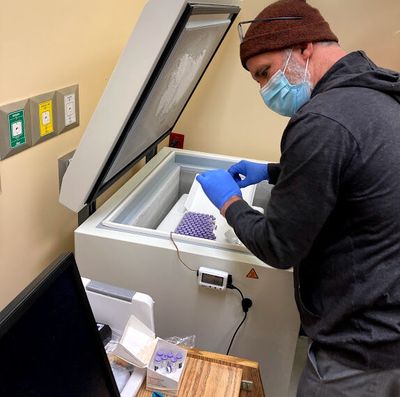Spokane-area firefighters helped meet early demand for COVID-19 vaccine in rural areas

It’s almost hard to imagine now, but there was once an intense demand for the COVID-19 vaccine.
In northeast Washington, the desire for doses exceeded the capacity of the local health care system.
Thus, the Northeast Tri County Health District needed a boost to its efforts to vaccinate people against COVID-19 earlier this year.
“We realized that as much as we were trying to do, it was not going to keep up with the demand within our communities for vaccine availability,” said Matt Schanz, administrator of the Northeast Tri County Health District.
It found help in local fire departments.
The help
Thanks to the same emergency mobilization system that allows a city like Spokane to send its firefighters to a wildfire burning halfway across the state, area firefighters were sent north this spring to help meet the surge of demand for the COVID-19 vaccine in rural communities.
It helped health officials streamline the process and ease the burden on existing providers, including Newport Hospital, in the early weeks after many people first became eligible for the vaccine.
The health district had about 23 people on its staff at the time, and just about every one of them was dropping regular duties and working entirely on standing up vaccine clinics. So when local officials learned they could request outside assistance from an incident management team – and it would be paid for by the state – they immediately acted.
“We’ve learned you’re better to be the first in line when there’s a scarcity of resources, so we said heck yeah, we could use the help,” Schanz said.
The Northeast Washington Interagency Incident Management Team, an organization consisting of people across multiple area public safety agencies, dispatched a team to assist the health district led by officials from Spokane County Fire District 9.
In coordination with local health officials, they implemented a plan to hold clinics at various times of the day across multiple locations, six days per week, in Stevens, Pend Oreille and Ferry counties.
“That coordination with Spokane County Fire District 9 was one of the best experiences that we’ve had throughout this whole pandemic response,” Schanz said.
The origin
The statewide mutual aid system used for vaccination efforts this year actually has its roots in Eastern Washington.
The Washington State Fire Services Mobilization Plan was developed following the ferocious firestorm of 1991, when strong winds and dry weather conditions resulted in more than 80 fires, 112 destroyed homes, and two deaths across Eastern Washington and North Idaho.
In the wake of that disaster, which soared beyond the capacity of rural fire departments, fire chiefs agreed to build a mutual aid plan that would allow any agency to call for outside help when it is overwhelmed.
The plan, which is coordinated by the State Fire Marshal’s Office, started as a way to respond only to fires but has since expanded to include all major risks – including a pandemic.
“We always talked about what we would do for this. Now we know,” said Chief Deputy State Fire Marshal Bill Slosson.
This year the state Department of Health had federal funding in hand to support vaccination efforts, but it was the Fire Marshal’s Office with the infrastructure and plan in place to mobilize resources. It tapped incident management teams to support vaccination campaigns in five areas across the state.
A vaccination clinic is not a wildfire, but the incident management team’s approach is much the same – identify the problem and build a plan, Slosson explained.
“A lot of this was partnering with the local health agencies,” Slosson said. “They know public health, but they’re not often called upon to do something like this and stand something up like that.”
The Spokane Fire Department was one of the agencies whose firefighters and personnel chipped in.
The Spokane Fire Department racked up nearly $500,000 in overtime pay and other costs as its staff helped administer COVID-19 vaccines in the northeast corner of the state. The department will be fully reimbursed by the state.
“Whether it’s a hazmat incident, or a pandemic, or a public health emergency or a wildland fire, we’re able to mobilize resources and get reimbursed directly from the state’s coffers,” Spokane Fire Chief Brian Schaeffer explained in a Spokane City Council meeting last week.
The Spokane Fire Department’s participation in the vaccination clinics ran from March 10 to May 4, and the state is now reimbursing the city for its participation – including overtime pay, travel and lodging for firefighters who staffed the clinic and the cost of backfilling shifts left open in Spokane.
Sending firefighters elsewhere can draw questions about risks while they’re out of town.
While she said she understood how important vaccinations are, especially to surrounding communities, Councilwoman Lori Kinnear questioned the safety of sending firefighters elsewhere when the Spokane Fire Department is already shorthanded.
“This is scary to me that we would send people to other jurisdictions when we’re so low ourselves,” Kinnear said.
Schaeffer responded that, in the event of an emergency, the personnel could be recalled and it would require only “drive time from wherever they are” to respond to a situation in Spokane.
The statewide mutual aid system, he added, is “the backstop” for significant incidents.
A pandemic fits that description.
In the Northeast Tri County Health District, it was critical that people in rural areas have access to the vaccine.
“We knew that the closer that we brought this to where people live, the more successful that we would be at trying to vaccinate people,” Schanz said.
In total, that incident management team helped administer about 16,000 doses of the vaccine.